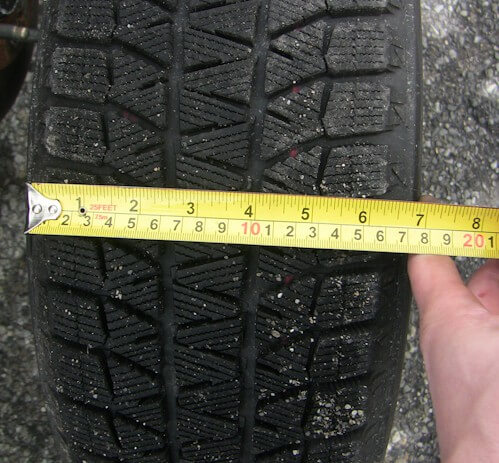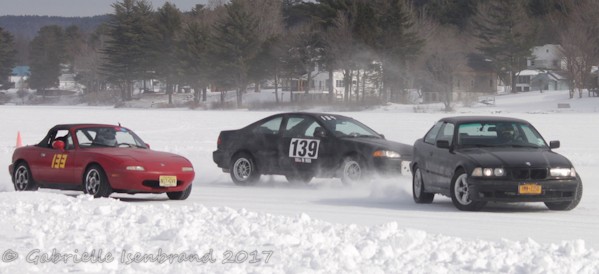Bridgestone Blizzak WS80 Tire Review
Published: January 21, 2017; updated: February 16, 2017
I have been a fan of Bridgestone Blizzaks for years, ever since putting WS-50s on my Nissan Maxima one winter. The Blizzak line is a premier winter tire in terms of grip level, and the latest installment does not disappoint. I also used WS-50s and WS-60s in ice racing, with WS-60s feeling rather lacking in ice grip compared to WS-50s. I have not had WS80s in a race yet but hope to do so soon. This review is for the tire's capabilies in street driving.
Tread Width
I was puzzled as to the narrow advertised tread width of Blizzaks, and when I received the tires I measured the tread. For the 185/55-15 size, 6.5" of tread width as advertised is even slightly on the generous side:

Ice Traction
The day after I installed Blizzaks on the car I ended up driving through an ice storm in Pennsylvania, Maryland and Virginia. Conditions in Pennsylvania primarily were freezing rain, and roads were treated with anti-icing agents. Surface was mostly covered with water rather than ice or snow. Maryland was very similar. By the time I got to Virginia the storm was departing, however temperatures dropped and untreated roads became covered in solid ice. State routes I traveled were mostly treated; smaller roads including county routes and local roads were mostly not treated.
On treated roads while driving through light water cover the car felt indistinguishable from driving in summer rain. Tires were thoroughly in their element.
On untreated roads WS80s provided more grip than I expected. The first indication of this was when I pulled into a gas station, opened the door and almost slipped while getting out - the parking lot was completely covered in ice. When I was driving through the lot I could not tell that the car was 100% driving on ice.
As I was navigating smaller untreated roads in Virginia, the tires were able to maintain about 35-40 mph while prevailing traffic speed (of the few souls brave enough to attempt to navigate the conditions) was more in the 10-15 mph range. Some cars were barely moving, probably doing less than 10 mph - I wonder why they were out driving at all.
At the limit WS80s were very progressive. This quality is particularly important for rear wheel drive cars, and Blizzaks perform admirably at the limit. It was fairly easy to sustain driving just under the tires' capabilities on ice covered roads.
My Miata is well balanced in terms of understeer and oversteer and WS80s preserved this aspect of the car. As long as the tires had some traction, front and rear of the car approached the grip limit in concert.
While it is hard to call driving ice-covered public roads easy in any circumstance, WS80s made such driving as low stress as possible. The tires easily get 10 out of 10 for ice grip.
Ice Racing
The ultimate ice traction test of winter tires is during an ice race:

Rear wheel drive in an ice race generally does not perform as well as front wheel drive, but depending on car setup and conditions can still be fun. I thus evaluated WS80s in two categories: outright performance compared to WS-50/WS-60 tires I ice raced several years ago and fun factor.
In terms of objective grip, WS80s performed well. Traction over packed snow was excellent; the car had more difficult time with loose snow as would be expected but overall the grip remained high. I was running about 1/3 of the way into the field while the course was mostly snow covered.
As the track transitioned into polished ice, the car became slower, It still remained predictable and controllable but now front wheel drive cars' advantage increased and I moved about 2/3 of the way into the pack. On polished ice the tires did what they could but rear wheel drive was too much of a handicap. Still I would say WS80s have superior ice grip to WS-60s and WS-50s with better wear - despite spinning the driving wheels over most of the day there was minimum heat-related wear on the tread, whereas WS-60s tended to melt in similar conditions.
In terms of fun factor, on a rear wheel drive car WS80s are definitely fun on snow in an ice race, acceptable when the track is partially snow covered, and sad when the track is primarily polished ice. On a front wheel drive car I expect WS80s to be fun in partial snow condition and acceptable on polished ice as a front wheel drive car can still be rotated on bare ice, it just takes longer.
Wet Grip
Full tread Blizzaks have no issues with water evacuation. Given the speed limits on public roads, the tires are capable of navigating wet roads as if they were dry.
Blizzaks' breakaway on wet pavement is again very progressive and easy to handle. The tires maintained the car's handling neutrality very well in the wet.
As the tires are capable of higher cornering speeds in the wet, sidewall softness starts to become noticeable. The tires definitey begin rolling over on their sides before the tread loses grip on wet pavement.
Dry Grip
I am rather impressed by WS80s dry grip. Reviews of older Blizzak models indicate that their dry grip was perhaps not strongest; if so, Bridgestone has addressed this concern thoroughly with WS80s.
WS80s' tread is very soft, typical of all Blizzak WS tires. Subjectively WS80 tread softness seems pretty close to that of a full race rain tire. WS80s' dry grip, in street driving, seems to be in the ballpark of my BFGoodrich Rivals which are a 200 treadwear summer extreme performance tire. This is quite a feat considering tread width of 185/55-15 WS80s that I have is 6.5", while tread width of the 205/50-15 Rivals I used for the comparison is 9" - nearly 40% more. The Blizzaks do have much softer sidewalls and roll over much more than Rivals, and I do not recommend bringing Blizzaks to a track day. But the tire's dry performance has thoroughly impressed me, and is well in excess of dry grip of an average all-season tire.
Steering response of WS80s is a bit delayed given the soft sidewalls, but not excessively so. After a month of driving on the tires I've gotten used to it and stopped noticing the lag.
The tires are very solid under braking and with a few hundred miles on them I have been able to brake near the limit without locking the tires up. Auditory feedback from WS80s under hard braking is very good.
Realistically, running WS80s at high lateral loads in the dry is not good for tread life because the tread is so soft.
Noise
WS80s emit a low volume hum. This is most noticeable around 30-40 mph when the car is running in top gear under light load. Under acceleration the engine note, even with the stock exhaust, drowns out the tire noise.
Longevity
At the time of this writing I am coming up on about 1000 miles of street driving on my set of WS80s. This includes long distance trips as well as city driving.
So far I would say the tires are holding up better than the WS-50 and WS-60 sets I have had. Previous generations of Blizzaks did not enjoy speeds in excess of 70 mph on dry pavement, and essentially melted in protest; WS80s seem to not mind. Most of the tread looks very good except the very inside edge which has the characteristic high temperature wear. I do maintain track alignment on the car - -3.5 degrees front camber, -3 degrees rear camber - because I continue to run track days in the winter, hence the environment in which Blizzaks are forced to operate is not ideal. I think the tires are wearing admirably well considering this. On a car with street alignment (under 1 degree of camber) the tires should have excellent wear.
 Visit our
Visit our